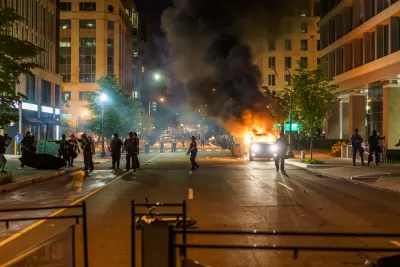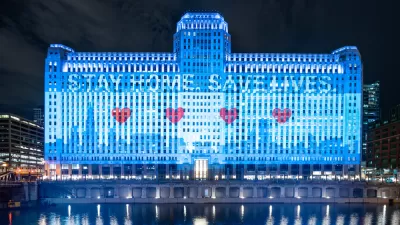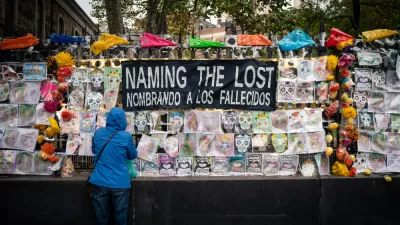An urban planning scholar of foreign conflict shares insights into how recent political unrest in the United States resembles and distinguishes from the ethnic and nationalistic conflict experienced in other countries in recent decades.

This article by Scott Bollens was originally published on Medium, and is republished here with permission and light editing.
As an urban planning scholar of foreign conflict for nearly 30 years, I have studied the dynamics of political conflict, fragmentation, and division in the cities of Northern Ireland, Lebanon, Israel and Palestine, and former Yugoslavia. These countries have been traumatized by deep ethnic and nationalistic inter-group conflict, sustained political violence, and a dissolution or decay of legitimacy of central government powers. Students and colleagues have typically asked me, "Can it happen here?" With the George Floyd protests engulfing American cities, they are now asking me, "Is it happening here?"
There are disturbing similarities between the politically polarized areas of my focus and the dynamics of American political and social life today. However, there are also assuring qualities of our system that make us different from these extreme cases. Yet, even my assurances may not be fully reassuring to you.
Here are the similarities:
Us versus them. Each side—the multicultural left and the far-right wing—portrays the other side of our political divide as not only different but wrong. We now resemble the "values-based disputes" of foreign examples where each side has a dismissive and demeaning lack of respect for the values of the other side. Each side views themselves as absolute and right, the other as inherently inferior, demanding that the other side conform to their correct view.
Assault on identity. Each side views the other side as a direct threat to the group's well-being and identity. For white nationalists, multiculturalism assaults their formulation of America. For black Americans, at stake are their bodies and lives. Beyond physical jeopardy has been the larger context of constant spewing of hatred and demeaning rhetoric from the White House for the past three and one-half years. An effort to separate Trump's sustained verbal assaults on minorities from what is happening in America today is not possible.
Symptom versus root. Troubling events occur—the suffocation of George Floyd and the beating of Rodney King in L.A. in 1991—that are symptoms of underlying systemic inequalities and injustices. These events are the sparks that ignite wide-ranging civil disturbances that seek to call attention to this systemic violence. The powers-that-be attempt to focus on, and even apologize for, the singular event. The oppressed and marginalized demand consideration of both the event and the longer history of grievance of which it is part.
Hopelessness breeds civil unrest. Loss of faith in the system of governance and policing leads to hopelessness. For many on the political left, our national politics and governance have failed. With legitimate means of expressing grievance cut off or ineffectual, civil disobedience becomes the only method remaining.
Battle over symbols and images. In past foreign country conflicts, particular actions—a flag atop a conquered building, graffiti that marks militia turf, checkpoints established outside neighborhoods—carried highly symbolic significance. Now, whether it is a white nationalist sporting an AR-15 on the steps of a state capital, a fiery protest at Lafayette Park near a darkened White House, or the riotous looting of Macy's in New York, these all carry highly potent meanings when their images hit our hyper-media environment. They test our understanding of moral and legal boundaries in a democracy and incite our emotions. Our social media system hyper-focuses these images, and through its algorithmic echo-chambering strategies, sends images and interpretations out in ways that containerize our worldviews, purifying them of all complexity and context. Dark web conspiracy theories enthrall their followers with the excitement of revealed prophecy. Social media terms and slang that cut become encrypted in our minds as simplifying and dangerous signposts that provide direction for many who are looking for something to hold on to amidst the chaos of civic meltdown.
Extremists dominate people’s attention. There is an important distinction between the mass of angry, nonviolent protesters and the propagators of more extreme violence against property (whether white nationalists or left-wing anti-fascists). Here, as in violent conflicts overseas, the extremists over time start to dominate public discussions. This detracts attention from the focus of protesters on systemic injustice. It plays into the hands of right-wing extremists who crave such multi-racial chaos.
Use of urban space in conflict. The territorial push and pull of protesters and police in American cities is akin to the actions of paramilitary militias in the tight quarters of places like Belfast and Beirut. To gain territory and to mark it is to assert political control.
Here are the assurances:
Government system is remaining intact. In contrast to foreign examples, we are not in a fight over the basic legitimacy of our government system. It remains intact, although increasingly strained and tattered. The fighting is over how goods, resources, and respect are distributed by our authorities, not over the foundations of our democratic system.
No coherent group-based strategy of violence. Viewing the streets of American cities, you likely think I am off here. In foreign examples of sustained polarization, there is commonly the emergence of strong ethnic militias on each side who excel in sustained and targeted attacks on the other side. In America, what is absent are systematic bombing or killing campaigns by either far-right wing groups or leftist extremists that target symbolic buildings or well-known individuals associated with the other side.
The distressing element of my assurances is that our democratic system of governance, while remaining intact and sovereign, is being severely eroded in function and stature. For many experiencing the pandemic and protests, governance in Washington, D.C. has morally failed. Loyalty to and respect for public authority are under assault by both the left and the right. We are in a downward spiral toward intractable division and, for many, the system of authority in this country appears unable, or unwilling, to reform itself. We may end up like Israel and Palestine where unresolved political conflict co-exists with dominating hegemonic control by one side, or like Lebanon where the fragmentation of its society bleeds into its political structure to produce governance dysfunction and gridlock.
Scott Bollens is professor of urban planning and public policy and Warmington Endowed Chair of Peace and International Cooperation, University of California, Irvine. He studies urbanism and political conflict in contested cities. His most recent book is Trajectories of Conflict and Peace: Jerusalem and Belfast since 1994 (London: Routledge, 2018). Forthcoming in 2021 is Bordered Cities and Divided Societies: Humanistic Essays of Conflict, Violence, and Healing (Routledge).
FULL STORY: Can it Happen Here? Is it Happening Here?

Alabama: Trump Terminates Settlements for Black Communities Harmed By Raw Sewage
Trump deemed the landmark civil rights agreement “illegal DEI and environmental justice policy.”

Planetizen Federal Action Tracker
A weekly monitor of how Trump’s orders and actions are impacting planners and planning in America.

Why Should We Subsidize Public Transportation?
Many public transit agencies face financial stress due to rising costs, declining fare revenue, and declining subsidies. Transit advocates must provide a strong business case for increasing public transit funding.

Understanding Road Diets
An explainer from Momentum highlights the advantages of reducing vehicle lanes in favor of more bike, transit, and pedestrian infrastructure.

New California Law Regulates Warehouse Pollution
A new law tightens building and emissions regulations for large distribution warehouses to mitigate air pollution and traffic in surrounding communities.

Phoenix Announces Opening Date for Light Rail Extension
The South Central extension will connect South Phoenix to downtown and other major hubs starting on June 7.
Urban Design for Planners 1: Software Tools
This six-course series explores essential urban design concepts using open source software and equips planners with the tools they need to participate fully in the urban design process.
Planning for Universal Design
Learn the tools for implementing Universal Design in planning regulations.
Caltrans
Smith Gee Studio
Institute for Housing and Urban Development Studies (IHS)
City of Grandview
Harvard GSD Executive Education
Toledo-Lucas County Plan Commissions
Salt Lake City
NYU Wagner Graduate School of Public Service





























